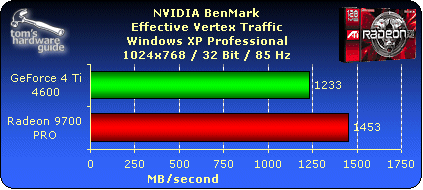ATi Radeon 9700 PRO - Pretender To The Throne
3D Performance In Detail
A card's performance in a game is influenced by many factors. If a game uses large textures, then fill rate is important. If it uses complex 3D models, triangle count becomes the crucial feature. Lastly, pixel and vertex shader effects are also very demanding. The following detailed tests allow us to observe the Radeon 9700 Pro and the GeForce4 Ti4600 in a side-by-side comparison.
Triangle Count
The polygon count of 3D models, i.e. the number of triangles used to create them, is continually increasing in modern games. Some examples of this are the greater detail in the cars of a racing game, or large outdoor levels with lots of vegetation, etc.
3DMark 2001


This test has the Radeon 9700 clearly leading the GeForce4 Ti, both with extra light sources enabled (eight light test, lower score table) and in the simple version. The Radeon's perfectly round scores seemed strange, though. It achieved the same score across all resolutions, while the GeForce4 showed a certain spread. We have yet to find an explanation for this behavior.
Benmark 5

BenMark is a small benchmark program developed by NVIDIA to test the T&L performance of a card.

In BenMark, the Radeon attains scores three times as high as those of the GeForce4 - despite the fact that it has "only" twice as many vertex shader units. This leads us to conclude that the Radeon's individual shader units are more efficient than those of the GeForce4 at almost identical clockspeeds.
Stay On the Cutting Edge: Get the Tom's Hardware Newsletter
Join the experts who read Tom's Hardware for the inside track on enthusiast PC tech news — and have for over 25 years. We'll send breaking news and in-depth reviews of CPUs, GPUs, AI, maker hardware and more straight to your inbox.

This test measures the amount of data that is transferred over the bus. Again, the Radeon 9700 can take a lot more strain than its competitor.
The Radeon is the clear winner in the category "highest triangle count." The GeForce4 Ti simply can't keep up.
Most Popular



